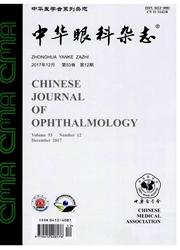

 中文摘要:
中文摘要:
目的比较人视网膜祖细胞和脑神经干细胞的体外分化潜能。方法分离8-12周人胎儿神经视网膜和脑皮质、纹状体神经干细胞,进行无血清体外培养;采用光镜和免疫细胞化学或荧光免疫细胞化学染色方法,分别观察在无血清和10%胎牛血清培养条件下,两种来源的神经干细胞分化后的细胞特性。结果两种来源的神经干细胞,均能在体外有或无血清培养条件下增殖并分化。视网膜祖细胞不但表达视网膜祖细胞标志物Pax-6,也可表达神经干细胞标志物.巢蛋白(Nestin)、成熟神经元标志物-微管相关蛋白2(Map2)、星形胶质细胞标志物-胶质纤维酸性蛋白(GFAP)、节细胞标志物Thy-1和视杆细胞标志物视紫红质(Rhodopsin);脑神经干细胞也能表达这些特异性细胞标志物。血清诱导分化时,视网膜祖细胞较难贴壁,贴壁细胞球伸出少而短的突起,单个细胞形态不清;而脑神经干细胞球易贴壁并伸出较长突起交织成网,大量细胞从细胞球中沿突起徙出,单个细胞形态清晰。结论人胎儿视网膜祖细胞和脑神经干细胞体外培养均具有向神经元、胶质细胞及视网膜终末细胞分化的能力;两种干细胞在进行血清诱导分化时,细胞的贴壁、迁移能力及分化后的细胞形态均存在差异。(中华腠科杂志,2006,42:901.907)
 英文摘要:
英文摘要:
Objective Investigating the potential of differentiation of human fetal retinal progenitor cells (hRPCs) and brain neural stem cells (hBNSCs) in vitro. Methods hRPCs and hBNSCs were isolated from human fetuses (8-12 weeks of gestation) and cultured in serum-free DMEM/F12 culture medium with N2 supplement, epidermal growth factor (EGF) and basic fibroblast growth factor (bFGF) or culture medium with 10% fetal bovine serum (FBS) but without EGF and bFGF. Immunocytochemical and immunofluorescence studies were conducted for identification of neural stem cells, retinal progenitors or the subtypes of neurons, astrocytes, retinal ganglion cells and rod photoreceptors with the specific antibodies for Nestin,Pax6, Map2, GFAP, Thy-1 and Rhodopsin, respectively. Results Both hRPCs and hBNSCs could proliferate and differentiate in DMEM/F12 + N2 with or without 10% FBS and expressed specific markers of immature neuroepithelial cells, retinal progenitors, mature neurons, astrocytes, retinal ganglion cells and rod photoreceptors, hBNSCs easily attached, spread out longer neurites and to form a network when cultured with serum contained medium, hRPCs were more difficult to attach and had only short dendrites. Conclusions Both hRPCs and hBNSCs can differentiate into retinal specific cell types in vitro. The adherent, migration and differential capacity of hRPCs and hBNSCs are different when these cells are induced by the serumcontained culture medium. (Chin J Ophthalmol , 2006,42:901-907)
 同期刊论文项目
同期刊论文项目
 同项目期刊论文
同项目期刊论文
 期刊信息
期刊信息
